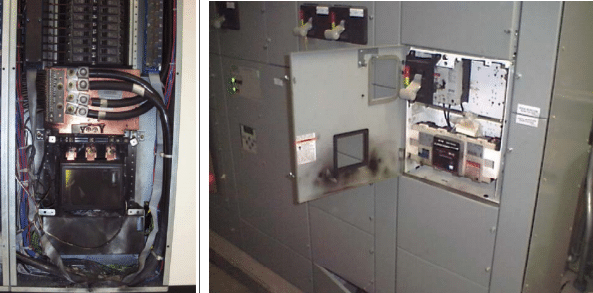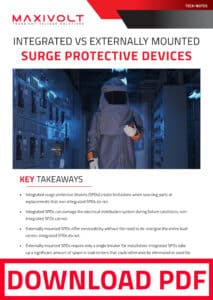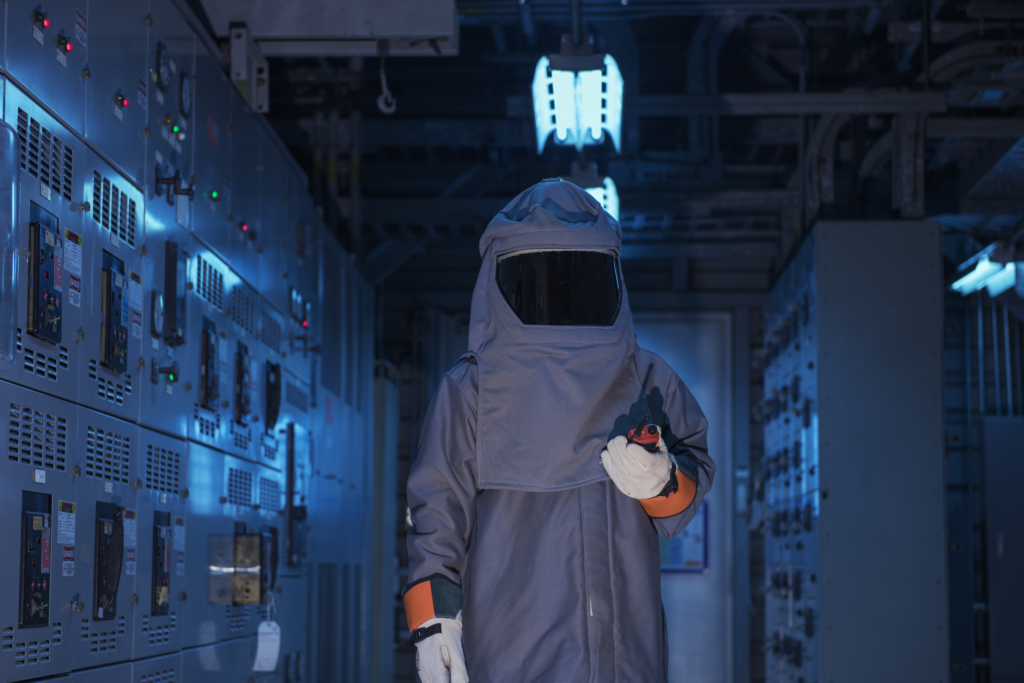Integrated vs Externally Mounted Surge Protective Devices
Key Takeaways
- Integrated surge protective devices (SPDs) create limitations when sourcing parts or replacements that non-integrated SPDs do not.
- Integrated SPDs can damage the electrical distribution system during failure conditions; non-integrated SPDs cannot.
- Externally mounted SPDs offer serviceability without the need to de-energize the entire load center; integrated SPDs do not.
- Externally mounted SPDs require only a single breaker for installation. Integrated SPDs take up a significant amount of space in load centers that could otherwise be eliminated or used for additional circuits.
Introduction
Transient voltage surge suppression systems (TVSS) protect electrical equipment and components from damage and misoperation caused by short duration voltage increases known as voltage transients, or voltage spikes/surges. Traditionally, TVSS (often referred to as surge protective devices – SPD for short) have been applied to electrical distribution systems in an aftermarket fashion. However, distribution equipment manufacturers have since integrated surge protection into their products, in some ways to the disadvantage of the end user.
Integral SPD Installations
Manufacturers of switchgear, switchboards, and panelboards introduced SPD-integrated assemblies in the late 1990’s as the devices became commonly specified/mandated within electrical plans. Integral SPD proponents assert that integration (1) simplifies installation, (2) lowers costs, and (3) improves product performance via shorter lead lengths.
Examination of Pro-Integral SPD Assertions
Simplification of Installation
Integral SPD installations create a sole source issue, leaving end users with manufacturer and panel-specific limitations should an SPD need repair/replacement. End users are limited to a single make and model. Discontinuations, availability, and long lead times limit the end user’s ability to maintain functional protection.
Lower Cost
Whether costs are lower is dependent on several variables including the makes and models being compared. Manufacturers of switchgear, switchboards, and panelboards can also disguise the actual SPD costs by adjusting the price of the entire gear package. At best, price discrepancies are murky.
Improves Product Performance (via shorter lead lengths)
While phase conductors are typically perceived to be shorter with integrated SPDs, neutral and ground conductors are often longer, negating any benefits of those shorter lead lengths.² It should also be noted that “with a typical service entrance and panelboard enclosure, the direct connection from the integral SPD to the energized conductors and the neutral is approximately 20 inches.”³ In most cases, installers can mount non-integral SPDs within 20 inches or less of connection points.

Additional Disadvantages of Integral SPDs
Electrical Distribution Equipment Damage
Integral SPDs can damage the electrical distribution system during failure conditions because of their direct exposure within the cabinet (as demonstrated in Figure 1).
Limiting Panel Space
Crowding and space limitations within panels are common issues. Integrated SPDs consume valuable slots within electrical panels, whereas externally mounted SPDs only require a single breaker for installation.
Serviceability Considerations
SPDs often require repair/replacement. The location and configuration of surge suppressors can affect serviceability. For safety, servicing an integrated SPD involves disconnecting power to the entire load center. Alternately, technicians can obtain special permits and wear specific personal protective equipment to service integral SPDs without de-energizing the load center. Adding to the cumbersome process of servicing integrated SPDs is the variability of load center disassembly required.
“An integrated SPD applied as shown in Figure 2, the facility manager is required to sign a “hot work” permit, and the technician is required to wear the appropriate PPE to remove the panels of the switchgear or switchboard to disconnect the SPD from the electrical distribution. Additional safety personnel are also required on-site while the technician performs the required servicing or maintenance on the integrated SPD.”2
Externally mounted SPDs bypass these headaches completely.

Conclusion
Integrated SPDs introduce unnecessary risks and a multitude of other disadvantages for end users when compared to externally mounted SPDs. Thoughtful and diligent installation of non-integrated SPDs with minimized lead lengths can provide the same performance advantages of integral SPDs. While electrical distribution equipment manufacturers have adapted how they integrate SPDs, more still needs to be done to protect exposed electrical distribution equipment and improve serviceability. The advantages of integrated SPDs do not justify the risks and challenges they create.
Resources
1. “Integrating SPDs in Switchgear & Switchboards Causes More Problems than it Solves,” Emerson.
2. “SURGE APPS SA–014: Integral vs. Non-Integral SPDs,” Thor Systems, Inc.
3. “Integral Versus Discrete Panel SPDs: A Comparison,” EC&M.





